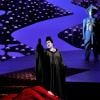
A night at the symphony usually doesn’t contain many surprises. Even if the pieces on a given program are unfamiliar, the music played by major orchestras tends to conform to a fairly narrow set of conventions — and Beethoven, Gustav Mahler, and Claude Debussy have long lost the subversive bite they once had.
The San Francisco Symphony’s concert Thursday evening was a shock to the system then. Only one work was on the program: the SF Symphony premiere of Ferruccio Busoni’s Piano Concerto in C Major, a massive, rarely performed composition from 1904. Igor Levit, here for a two-week residency with the orchestra, was the soloist. The piece lasts well over an hour and contains some of the most difficult music ever written for the piano. But the sheer energy and dynamism of the score also made for one of the most enjoyable orchestral experiences I can remember. Busoni absorbs the characteristic features of the Romantic concerto and dials them up to 11. For any weary concertgoer, this performance was like a shot of pure adrenaline.

Over its five movements, this sprawling concerto presents a kaleidoscope of styles, atmospheres, and moods. Levit delivered a sparkling account of the piece, backed by an assured Esa-Pekka Salonen and a vigorous, energetic SF Symphony and Chorus. Busoni, who premiered the concerto himself, was one of the greatest virtuosos of his time, but his piano writing is not the seductive emotionality of Franz Liszt or Sergei Rachmaninoff. Rather, the piano grinds away along with the orchestra like a mechanical engine, propelling the ensemble forward like a heat-seeking missile.
Busoni was a radical. In his writings, he anticipated the advent of microtonal and electronic music, and some of his works test the limits of traditional harmony. But he was also a classicist. He believed in the importance of tradition, and he favored the formally rigorous technique of Johannes Brahms over the imagistic and programmatic aesthetic of Richard Wagner.
Busoni’s concerto reflects these contradictions. As if to counterbalance the experimentalism of the five-movement piece (which includes an “invisible” male choir singing an exoticist German poem in the final movement), Busoni places the concerto in C major, the most basic and elemental of keys. Although the work is scored for large orchestra, the orchestration is surprisingly transparent; the phrases are orderly and well demarcated, and the harmony frequently resolves into stable consonant chords.

The piece requires full commitment from its performing forces, and Levit, Salonen, and the orchestra and chorus were undaunted by the task. Levit achieved his characteristically crystalline tone, executed Busoni’s never-ending reams of arpeggios with complete assurance, and plunged tirelessly through the kinetic and playful second and fourth movements. If the performance exhausted him, he certainly didn’t show it. Salonen was in his element, too; he led the orchestra, which sounded particularly robust and present, with exuberance.
Levit presents himself as a rebel. Like Busoni, he has a utopian imagination and ambitions that overleap the conventional strictures of classical music. He is known for tackling imposing repertoire — his debut recording was of Beethoven’s late piano sonatas — and his nimble, colorful playing generally lives up to his philosophical pretensions, even if some of it conveys the hyperactive energy of a child in a rush. A few of Levit’s unconventional choices, like replacing the usual tuxedo with an all-black getup ripped out of Berlin’s club scene and his Glenn Gould-esque gestures, have a whiff of unconventionality for its own sake. Like some of his political pronouncements, these choices advertise Levit’s rebelliousness without substantively undermining the traditions they seek to resist.

By far the most radical, surprising, and engaging element of the evening was the substance of Busoni’s concerto itself. The success of this program — the hall was packed on Thursday night and the performance rapturously received — is a testament to the power of adventurous, outsized, even unreasonable pieces of art. Recently, the production of such works as Richard Strauss’s fairy-tale opera Die frau ohne Schatten at SF Opera, or Ari Aster’s three-hour experimental epic film Beau Is Afraid, suggests that there is still an appetite for art that is challenging, ambitious, and willing to border on the absurd.
The SF Symphony’s performance was a refreshing reminder that music — even a piano concerto that’s more than 100 years old — can elicit feelings of awe, surprise, and wonder. And that, in the end, is what it’s all about.




